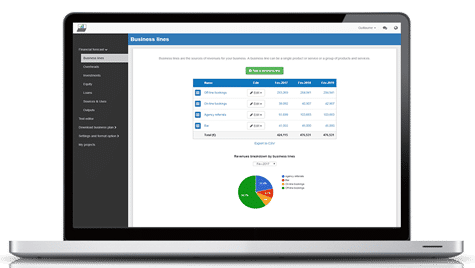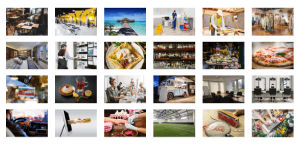How to create a financial forecast for a craft beer bar?

Creating a financial forecast for your craft beer bar, and ensuring it stays up to date, is the only way to maintain visibility on future cash flows.
This might sound complex, but with the right guidance and tools, creating an accurate financial forecast for your craft beer bar is not that hard.
In this guide, we'll cover everything from the main goal of a financial projection, the data you need as input, to the tables that compose it, and the tools that can help you build a forecast efficiently.
Without further ado, let us begin!
Why create and maintain a financial forecast for a craft beer bar?
In order to prosper, your business needs to have visibility on what lies ahead and the right financial resources to grow. This is where having a financial forecast for your craft beer bar becomes handy.
Creating a craft beer bar financial forecast forces you to take stock of where your business stands and where you want it to go.
Once you have clarity on the destination, you will need to draw up a plan to get there and assess what it means in terms of future profitability and cash flows for your craft beer bar.
Having this clear plan in place will give you the confidence needed to move forward with your business’s development.
Having an up-to-date financial forecast for a craft beer bar is also useful if your trading environment worsens, as the forecast enables you to adjust to your new market conditions and anticipate any potential cash shortfall.
Finally, your craft beer bar's financial projections will also help you secure financing, as banks and investors alike will want to see accurate projections before agreeing to finance your business.
Need a solid financial forecast?
The Business Plan Shop does the maths for you. Simply enter your revenues, costs and investments. Click save and our online tool builds a three-way forecast for you instantly.
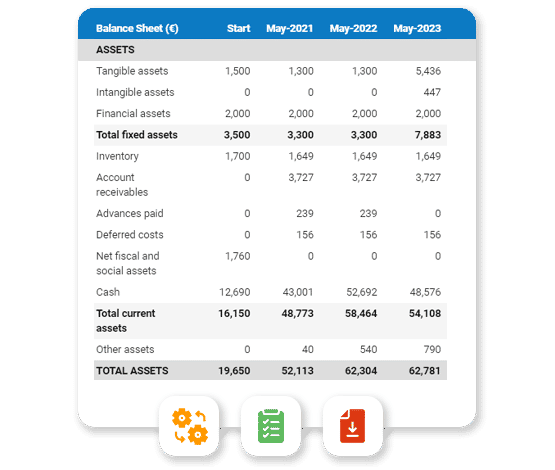
What information is used as input to build a craft beer bar financial forecast?
A craft beer bar's financial forecast needs to be built on the right foundation: your assumptions.
The data required to create your assumptions will depend on whether you are a new or existing craft beer bar.
If you are creating (or updating) the forecast of an existing craft beer bar, then your main inputs will be historical accounting data and operating metrics, and your team’s view on what to expect for the next three to five years.
If you are building financial projections for a new craft beer bar startup, you will need to rely on market research to form your go-to-market strategy and derive your sales forecast.
For a new venture, you will also need an itemised list of resources needed for the craft beer bar to operate, along with a list of equipment required to launch the venture (more on that below).
Now that you understand what is needed, let’s have a look at what elements will make up your craft beer bar's financial forecast.
The sales forecast for a craft beer bar
The sales forecast, also called topline projection, is normally where you will start when building your craft beer bar financial forecast.
Creating a coherent sales projection boils down to estimating two key drivers:
- The average price
- The number of monthly transactions
To do this, you will need to rely on historical data (for an existing business), market research data (for both new and existing craft beer bars), and consider the elements below:
- As the demand for craft beer continues to rise, your bar may see an increase in the average price per transaction as customers are willing to pay a premium for unique and high-quality beers.
- Changes in the availability and pricing of key ingredients used in craft beer production, such as hops and barley, can impact the cost of your products and potentially affect your average price per transaction.
- The popularity of seasonal and limited edition craft beers can create fluctuations in your average price per transaction, as customers may be willing to pay more for these unique offerings.
- The local and regional economy can also impact your average price per transaction, as economic downturns may lead to a decrease in disposable income and therefore a decrease in the amount customers are willing to spend on craft beer.
- The opening of new craft beer bars in your area may create competition and potentially drive down your average price per transaction as customers have more options to choose from.
After the sales forecast comes the operating expenses budget, which we will now look into in more detail.
Need inspiration for your business plan?
The Business Plan Shop has dozens of business plan templates that you can use to get a clear idea of what a complete business plan looks like.
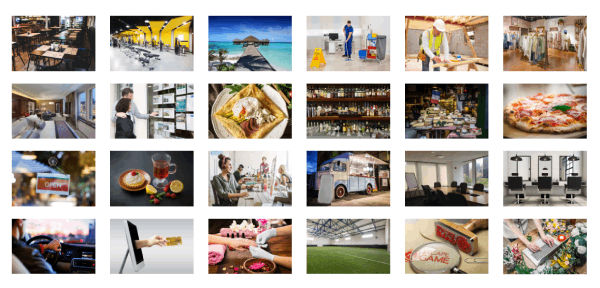
The operating expenses for a craft beer bar
The next step is to estimate the expenses needed to run your craft beer bar on a day-to-day basis.
These will vary based on the level of sales expected, and the location and size of your business.
But your craft beer bar's operating expenses should include the following items at a minimum:
- Staff Costs: This includes salaries, hourly wages, and benefits for your bartenders, servers, kitchen staff, and other employees.
- Accountancy Fees: You'll need to hire an accountant to help you manage your finances, prepare taxes, and keep your books in order.
- Insurance Costs: It's important to have insurance to protect your business from any potential risks, such as liability insurance for accidents or property insurance for damages.
- Software Licences: You'll need to purchase licenses for any software you use to run your bar, such as point of sale systems, inventory management software, or accounting software.
- Banking Fees: You'll have to pay fees for maintaining a business bank account, processing credit card transactions, and other banking services.
- Rent: This is the cost of leasing the space for your craft beer bar. It may also include utilities, such as electricity, water, and internet.
- Inventory: You'll need to purchase beer, wine, spirits, and other ingredients to create your craft beers. This also includes the cost of restocking and managing inventory levels.
- Marketing and Advertising: You'll need to promote your craft beer bar to attract customers. This may include creating a website, printing flyers, or hosting events.
- Licenses and Permits: You'll need to obtain various licenses and permits to legally operate your craft beer bar, such as a liquor license, health permits, and business permits.
- Kitchen Supplies: If your craft beer bar serves food, you'll need to purchase kitchen supplies, such as plates, utensils, and cooking equipment.
- Cleaning and Maintenance: Keeping your bar clean and in good condition is important for customer satisfaction. This includes cleaning supplies, repairs, and maintenance.
- Music and Entertainment: To create a fun and lively atmosphere, you may want to consider hiring musicians or hosting events. This will require a budget for paying performers and purchasing music equipment.
- Training and Development: Investing in your employees' training and development is important for maintaining high-quality service and keeping up with industry trends.
- Legal Fees: As a business owner, you may need to seek legal advice for various matters, such as creating contracts, handling disputes, or obtaining trademarks.
- Credit Card Processing Fees: If you accept credit card payments, you'll have to pay fees for each transaction. These fees can add up and should be factored into your operating expenses.
This list is, of course, not exhaustive, and you'll have to adapt it according to your precise business model and size. A small craft beer bar might not have the same level of expenditure as a larger one, for example.
What investments are needed to start or grow a craft beer bar?
Your craft beer bar financial forecast will also need to include the capital expenditures (aka investments in plain English) and initial working capital items required for the creation or development of your business.
For a craft beer bar, these could include:
- Brewing Equipment: This includes all the necessary equipment for brewing and storing craft beer such as fermenters, kegs, mash tuns, and bottling machines. These are essential fixed assets for a craft beer bar as they directly impact the quality and quantity of the beer produced.
- Bar Equipment: This includes items such as tap systems, refrigerators, and ice machines. These are crucial for storing and serving craft beer at the optimal temperature and maintaining the quality and taste of the beer.
- Furniture and Fixtures: This includes tables, chairs, bar stools, and other furniture and fixtures needed to create a comfortable and inviting atmosphere for customers. These items are essential for creating a unique and memorable experience for customers at a craft beer bar.
- Point of Sale System: A modern and efficient point of sale system is crucial for managing transactions, tracking inventory, and generating reports. This is a necessary fixed asset for any craft beer bar to ensure smooth operations and accurate financial records.
- Sound and Lighting Equipment: A craft beer bar often hosts live music events or other forms of entertainment. Therefore, investing in sound and lighting equipment is necessary to create a lively and engaging atmosphere for customers. These are essential fixed assets for a craft beer bar to enhance the overall customer experience.
Again, this list will need to be adjusted according to the size and ambitions of your craft beer bar.
Need a convincing business plan?
The Business Plan Shop makes it easy to create a financial forecast to assess the potential profitability of your projects, and write a business plan that’ll wow investors.
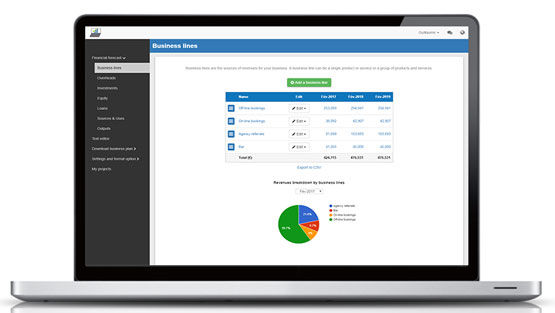
The financing plan of your craft beer bar
The next step in the creation of your financial forecast for your craft beer bar is to think about how you might finance your business.
You will have to assess how much capital will come from shareholders (equity) and how much can be secured through banks.
Bank loans will have to be modelled so that you can separate the interest expenses from the repayments of principal, and include all this data in your forecast.
Issuing share capital and obtaining a bank loan are two of the most common ways that entrepreneurs finance their businesses.
What tables compose the financial plan for a craft beer bar?
Now let's have a look at the main output tables of your craft beer bar's financial forecast.
The forecasted profit & loss statement
The profit & loss forecast gives you a clear picture of your business’ expected growth over the first three to five years, and whether it’s likely to be profitable or not.
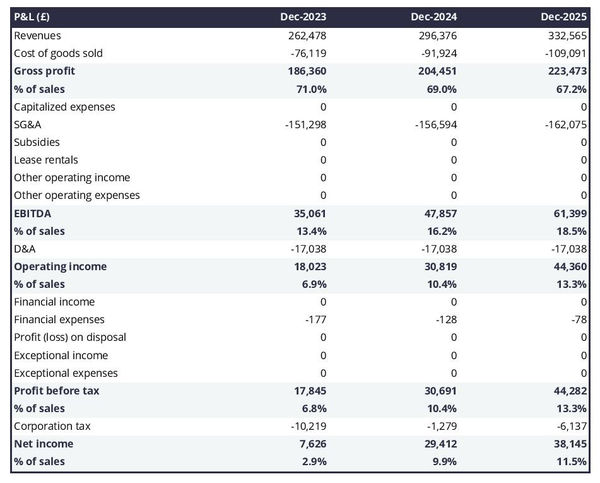
A healthy craft beer bar's P&L statement should show:
- Sales growing at (minimum) or above (better) inflation
- Stable (minimum) or expanding (better) profit margins
- A healthy level of net profitability
This will of course depend on the stage of your business: numbers for an established craft beer bar will look different than for a startup.
The projected balance sheet
Your craft beer bar's projected balance sheet provides a snapshot of your business’s financial position at year-end.
It is composed of three types of elements: assets, liabilities and equity:
- Assets: represent what the business possesses including cash, equipment, and accounts receivable (money owed by clients).
- Liabilities: represent funds advanced to the business by lenders and other creditors. They include accounts payable (money owed to suppliers), taxes payable and loans from banks and financial institutions.
- Equity: is the combination of what has been invested by the business owners and the cumulative profits and losses generated by the business to date (which are called retained earnings). Equity is a proxy for the value of the owner's stake in the business.
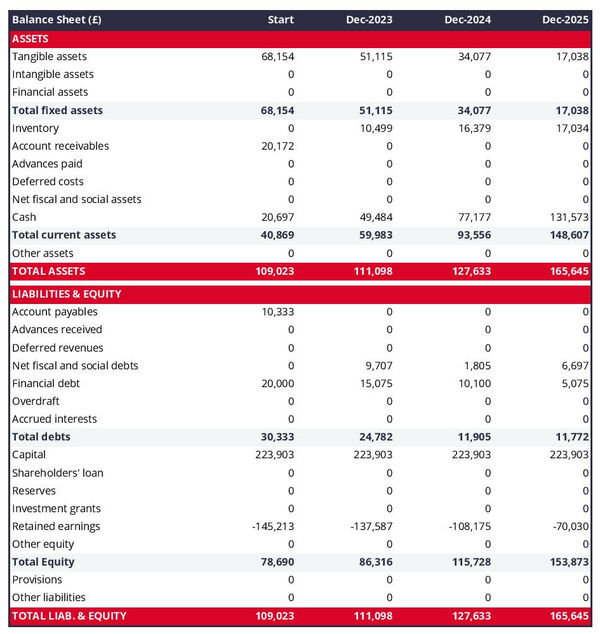
The projected cash flow statement
A projected cash flow statement for a craft beer bar is used to show how much cash the business is generating or consuming.
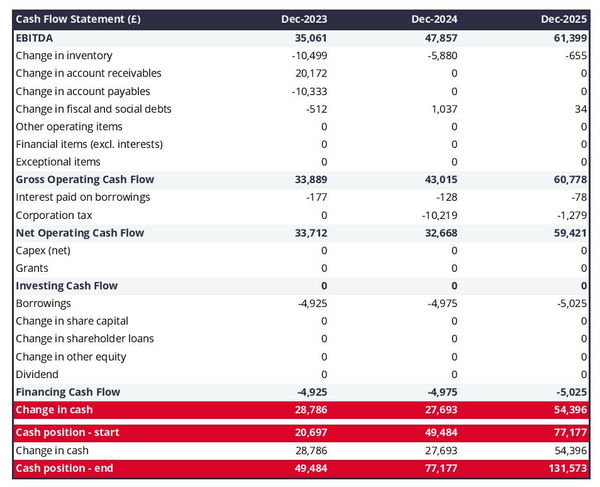
The cash flow forecast is usually organised by nature to show three key metrics:
- The operating cash flow: do the core business activities generate or consume cash?
- The investing cash flow: how much is the business investing in long-term assets (this is usually compared to the level of fixed assets on the balance sheet to assess whether the business is regularly maintaining and renewing its equipment)?
- The financing cash flow: is the business raising new financing or repaying financiers (debt repayment, dividends)?
Cash is king and keeping an eye on future cash flows is imperative for running a successful business. Therefore, you should pay close attention to your craft beer bar's cash flow forecast.
If you are trying to secure financing, note that it is customary to provide both yearly and monthly cash flow forecasts in a financial plan - so that the reader can analyze seasonal variation and ensure the craft beer bar is appropriately capitalised.
Need a solid financial forecast?
The Business Plan Shop does the maths for you. Simply enter your revenues, costs and investments. Click save and our online tool builds a three-way forecast for you instantly.

Which tool should you use to create your craft beer bar's financial projections?
Building a craft beer bar financial forecast is not difficult provided that you use the right tool for the job. Let’s see what options are available below.
Using online financial forecasting software to build your craft beer bar's projections
The modern and easiest way is to use professional online financial forecasting software such as the one we offer at The Business Plan Shop.
There are several advantages to using specialised software:
- You can easily create your financial forecast by letting the software take care of the financial calculations for you without errors
- You have access to complete financial forecast templates
- You get a complete financial forecast ready to be sent to your bank or investors
- You can easily track your actual financial performance against your financial forecast, and recalibrate your forecast as the year goes by
- You can create scenarios to stress test your forecast's main assumptions
- You can easily update your forecast as time goes by to maintain visibility on future cash flows
- You have a friendly support team on standby to assist you when you are stuck
- It’s cost-efficient and much cheaper than using an accountant or consultant (see below)
If you are interested in this type of solution, you can try our forecasting software for free by signing up here.
Calling in a financial consultant or chartered accountant
Outsourcing the creation of your craft beer bar financial forecast is another possible solution.
This will cost more than using software as you can expect as your price will have to cover the accountant’s time, software cost, and profit margin.
Price can vary greatly based on the complexity of your business. For a small business, from experience, a simple three-year financial forecast (including a balance sheet, income statement, and cash flow statement) will start at around £700 or $1,000.
Bear in mind that this is for forecasts produced at a single point in time, updating or tracking your forecast against actuals will cost extra.
If you decide to outsource your forecasting:
- Make sure the professional has direct experience in your industry and is able to challenge your assumptions constructively.
- Steer away from consultants using sectorial ratios to build their client’s financial forecasts (these projections are worthless for a small business).
Why not use a spreadsheet such as Excel or Google Sheets to build your craft beer bar's financial forecast?
You and your financial partners need numbers you can trust. Unless you have studied finance or accounting, creating a trustworthy and error-free craft beer bar financial forecast on a spreadsheet is likely to prove challenging.
Financial modelling is very technical by nature and requires a solid grasp of accounting principles to be done without errors. This means that using spreadsheet software like Excel or Google Sheets to create accurate financial forecasts is out of reach for most business owners.
Creating forecasts in Excel is also inefficient nowadays:
- Software has advanced to the point where forecasting can be done much faster and more accurately than manually on a spreadsheet.
- With artificial intelligence, the software is capable of detecting mistakes and helping decision-making.
Spreadsheets are versatile tools but they are not tailor-made for reporting. Importing your craft beer bar's accounting data in Excel to track actual vs. forecast is incredibly manual and tedious (and so is keeping forecasts up to date). It is much faster to use dedicated financial planning tools like The Business Plan Shop which are built specially for this.
Need a convincing business plan?
The Business Plan Shop makes it easy to create a financial forecast to assess the potential profitability of your projects, and write a business plan that’ll wow investors.

Use our financial projection templates for inspiration
The Business Plan Shop has dozens of financial forecast templates available.
Our examples contain a complete business plan with a financial forecast and a written presentation of the company, the team, the strategy, and the medium-term objectives.
Whether you are just starting out or already have your own craft beer bar, looking at our financial forecast template is a good way to:
- Understand what a complete business plan should look like
- Understand how you should model financial items for your craft beer bar
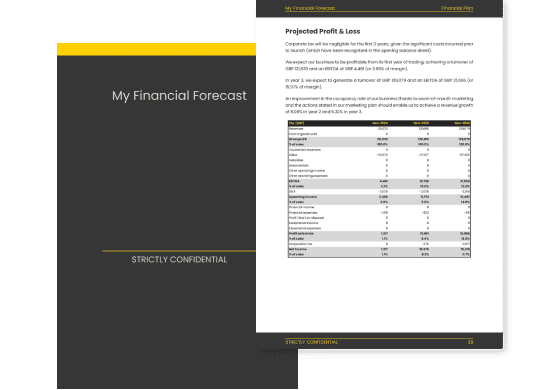
Takeaways
- Having a financial forecast enables you to visualise the expected growth, profitability, and cash generation for your business over the next three to five years.
- Tracking actuals vs. forecast and keeping your financial projections up-to-date is the only way to get a view on what your craft beer bar future cash flows may look like.
- Using financial forecasting software is the mordern and easy way to create and maintain your forecasts.
This is the end of our guide on how to build the financial forecast for a craft beer bar, we hope you found it useful. Don't hesitate to contact us if you want to share your feedback or have any questions.
Need inspiration for your business plan?
The Business Plan Shop has dozens of business plan templates that you can use to get a clear idea of what a complete business plan looks like.

Also on The Business Plan Shop
Know someone who owns or is thinking of starting a craft beer bar? Share our forecasting guide with them!

